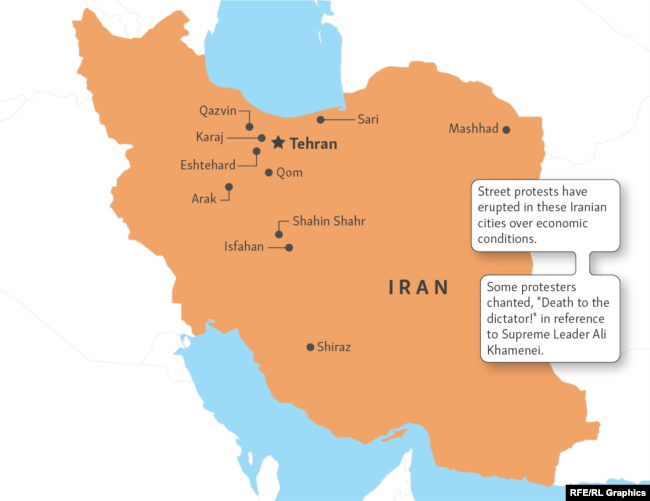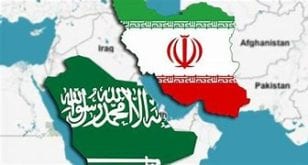Radiofarda – The reformist-conservative dichotomy in the Islamic republic has been misleading almost everyone trying to understand modern Iran. The dichotomy has also created a deadlock that has hindered political development.
The failure of the biggest broad-based conservative coalition in the history of the Islamic Republic of Iran since 1979 in the 2017 Presidential election, and the statement by the most popular reformist figure in Iran about the reformists’ declining electability are only two of the many reasons why the current factional system no longer works.
If one needs one more convincing indication about the demise of the bi-factional system and the conservative-reformist dichotomy in Iran’s modern politics, that would be a slogan from late 2017, which still echoes in over 100 Iranian cities.

Enraged demonstrators fed up with Iran’s rigid political system among other things, chanted a slogan in December 2017 and January 2018 which damned both the conservative and reformist factions: “Reformists, Conservatives, It’s The End of the Story.”
A commentary in reformist Sharq newspaper in May observed that “the deadlocks facing the two main factions and lack of people’s interest in them has led to discussions about a third faction to emerge in Iranian politics.”
Conservatives also appear to be thinking of the same problem. Assadollah Badamchian, the leader of the Islamic Coalition Party, said that both reformists and conservative have reached the end of their life, adding that “We should be thinking of a new faction.”
He wrote on his Twitter: “The combination of factions will take another shape at the beginning of the fifth decade after the 1979 revolution. Conservatism with its current definition cannot unify people and give them hope. Reformism has also led to frustrations. So, we need a new plan.”
Some Iranian politicians including former conservative mayor of Tehran Mohammad Baqer Qalibaf and former hardline President Mahmoud Ahmadinejadappear to have realized this, at least months before the nationwide protests in 2017-2018.
Qalibaf had said openly after being sidelined by allies and political rivals in the 2017 presidential race that he was going to form a third faction he called “neo-conservatives,” and Ahmadinejad trumpeted the failure of both existing factions in several open letters he published in 2018.
At the same time, on numerous occasions, Iranian conservatives distanced themselves from Ahmadinejad, making it known publicly that the neo-con former president belonged to a camp of his own.
The same kind of disillusionment appeared in the reformist camp just ahead of the 2016 Majles and 2017 Presidential elections. They came up with two new reformist political parties, one led by an ambitious figure close to the household of Iran’s Supreme Leader Ali Khamenei, and another one, whose members and leaders were the same as the Participation Party of Islamic Iran which although was not officially outlawed, everyone knew that it had been silenced, to say the least.
In the meantime, commentators in Tehran agree that Iranian reformists have lost their popularity and credibility as Rouhani failed to live up to reform promises. Most who had voted for him now feel being let down by reformists.
Iranian commentator Sadeq Zibakalam, however, said an interview with reformist newspaper Aftab Yazd, “reformists did not make a mistake by supporting Rouhani. It was the President who did not meet some of his promises and did not even once mention some of his promises during the past two years, surrendering to conservatives.”
On the other hand, as Leila Sharif who is close to Majles Speaker Larijani, observed in a commentary on Khabar Online website, reformists have been defeated and isolated in the Iranian Parliament because of…their inaction.
She also observed that prominent reform figure Mohammad Reza Aref’s defeat in the Majles Presidium election in May was another indication of reformists’ failure.
Her shocking observation was that some pro-reform figures had admitted that the failure was caused by the behavior of turncoat pseudo-reformists who won the 2016 Majles election on their reformist ticket, but behaved differently in parliament, supporting the hardliners.
In the meantime, Sharq observed that some have even tried to pretend that the so-called moderate Rouhani administration is the third faction. But while the current administration looks at itself as part of the discourse of the two conservative and reformist factions and in fact the moderation group is a diluted version of the same right and left groups, neither the moderates themselves like to be known as the third faction, nor others recognize them as such.”
So, where is the new faction to come from in order to put an end to the domestic political deadlock in Iran? Pro-reform analyst Abbas Abdi told reformist daily Etemad in May that the emergence of new groups and new discourse in the 2020 Majles election is unlikely … unless there are fundamental changes in Iranian politics. In that case, things will be different. But such a thing will not take place under the current situation, although everything is possible in Iran.”
 Shabtabnews In this dark night, I have lost my way – Arise from a corner, oh you the star of guidance.
Shabtabnews In this dark night, I have lost my way – Arise from a corner, oh you the star of guidance.



